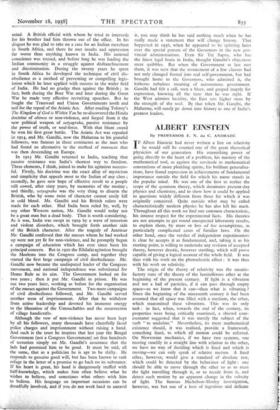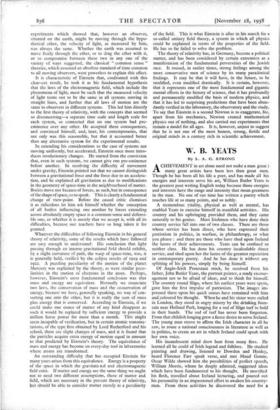ALBERT EINSTEIN
By PROFESSOR E. N. da C. ANDRADE
IF Albert Einstein had never written a line on relativity he would still be counted one of the great theoretical physicists of our generation. His astonishing power of going directly to the heart of a problem, his mastery of the mathematical tool, as against the servitude to mathematical conventions of more plodding spirits, his brilliant generalisa- tions, have found expression in achievements of fundamental importance outside the field for which his name stands in the popular mind. He was one of the first to realise the scope of the quantum theory, which dominates present-day physics and chemistry, and to show how it could be applied to questions widely different from those for which it was originally conceived. Quite outside what may be called characteristically modern physics he has also left his mark. Throughout all this work we find one common characteristic, his intense respect for the experimental facts. His theories are not attempts to get round unexpected laboratory results, to explain them, by more or less ad hoc assumptions, as particularly complicated cases of familiar laws. On the other hand, once the verdict of independent experimenters is clear he accepts it as fundamental, and, taking it as his starting point, is willing to undertake any revision of accepted theory, however drastic, however startling, which will prove capable of giving a logical account of the whole field. It was thus with his work on the photoelectric effect : it was thus with his work on relativity.
The origin of the theory of relativity was the unsatis- factory state of the theory of the luminiferous ether at the beginning of the present century. If light is a vibration and not a hail of particles, if it can pass through empty space—as we know that it can—then what is vibrating ? Since the beginning of the nineteenth century it had been assumed that all space was filled with a medium, the ether, which transmitted these vibrations. This was its only task : in fact, when, towards the end of the century, its properties were being critically examined, a shrewd com- mentator suggested that it was merely the subject of the verb " to undulate." Nevertheless, its mere mathematical existence should, it was realised, provide a framework, something fixed, to which all motion could be referred. On Newtonian mechanics, if we have two systems, one moving steadily in a straight line with relation to the other, we have no way of deciding which is fixed and which is moving—we can only speak of relative motion. A fixed ether, however, would give a standard of absolute rest, which could be detected by the behaviour of light : one should be able to move through the ether so as to meet the light travelling through it, or to recede from it, and detect such motion by an apparent change in the velocity of light. The famous Michelson-Morley investigation, however, was but one of a host of ingenious and delicate experiments which showed that, however an observer, situated on the earth, might be moving through the hypo- thetical ether, the velocity of light, as measured by him, was always the same. Whether the earth was assumed to move freely through the ether, or to drag the ether with it, or to compromise between these two in any one of the variety of ways suggested, the classical " common sense " theories, which assumed an absolute standard of time common to all moving observers, were powerless to explain this effect.
It is characteristic of Einstein that, confronted with this clear-cut result, he took it as his fundamental hypothesis that the laws of the electromagnetic field, which include the phenomena of light, must be such that the measured velocity of light turns out to be the same in all systems moving in straight- lines, and further that all laws of motion are the same to observers in different systems. This led him directly to the first theory of relativity, with the concepts that seemed so disconcerting—a separate time scale and length scale for each system, so connected that no one system had pre- eminence over any other. He accepted these consequences, and convinced himself, and, later, his contemporaries, that not only was this reasonable, but that it accounted better than any alternative system for the experimental results.
In extending his considerations to the case of systems not • moving uniformly, but accelerated, Einstein once more intro- duces revolutionary changes. He started from the conviction that, even in such systems, we cannot give one pre-eminence before another. In resolving the difficulty of movement under gravity, Einstein pointed out that we cannot distinguish between a gravitational force and the force due to an accelera- tion, and he explained all gravitation as due to modifications in the geometry of space-time in the neighbourhood of matter. Bodies move not because of forces, as such, but in consequence of the shape of space, so to speak. This is clearly a fundamental change of view-point. Before the casual critic dismisses it as ridiculous let him ask himself whether the conception of all bodies influencing one another by forces extending across absolutely empty space is a common-sense and defensi- ble one, or whether it is merely that we accept it, with all its difficulties, because our teachers have so long taken it for granted.
Whatever the difficulties of following Einstein in his general theory of relativity, some of the results which have followed are easy enough to understand. His conclusion that light passing through an intense gravitational field should exhibit, by a slight curvature of path, the warp of space-time, was, it is generally held, verified by the eclipse results of 1919 and 1922. A puzzling peculiarity of the motion of the, planet Mercury was explained by the theory, as were similar pecu- liarities in the motion of electrons in the atom. Perhaps, however, Einstein's most fundamental conclusion was that mass And energy are equivalent. Normally we enunciate two laws, the conservation of mass and the conservation of energy, because we have, generally speaking, no way of con- verting one into the other, but it is really the sum of mass plus energy that is 'conserved. According to Einstein, if we could make one ounce of matter of any kind disappear as such it would be replaced by sufficient energy to provide a million horse power for more than a month. This might seem incapable of verification, but in certain atomic transmu- tations, of the type first obtained by Lord Rutherford and his school, there are slight changes of mass, and it is found that the particles acquire extra energy of motion equal in amount to that predicted by Einstein's theory. The equivalence of mass and energy has become an every-day tool in laboratories where atoms are transformed.
An outstanding difficulty that has occupied Einstein for many years arises from this equivalence. Energy is a property of the space in which the gravitational and electromagnetic field exist. If matter and energy are the same thing we ought not to need two different assumptions, those of matter and field, which are necessary in the present theory of relativity, but should be able to consider matter merely as a peculiarity of the field. This is what Einstein is after in his search for a so-called unitary field theory, a system in which all physics could be explained in terms of the properties of the field. He has so far failed to solve the problem.
The theory of relativity has, in Germany, become a political matter, and has been considered by certain extremists as a manifestation of the fundamental perversities of the Jewish race. It roused, in earlier times, strong feelings among the more conservative men of science by its many paradoxical findings. It may be that it will have, in the future, to be modified, even modified drastically. It is certain, however, that it represents one of the most fundamental and gigantic mental efforts in the history of science, that it has profoundly and permanently modified the basis of modern physics, and that it has led to surprising predictions that have been abun- dantly verified in the laboratory, the observatory and the study. To say that Einstein is a second Newton is to exaggerate, for, apart from his mechanics, Newton created mathematical physics out of nothing, and also carried out experiments that remain a model for all ages. It is, however, unjust to suggest that he is not one of the most honest, strong, fertile and original minds in a century rich in scientific achievement.

























































 Previous page
Previous page